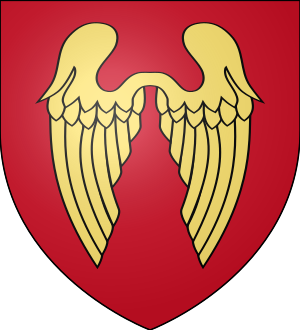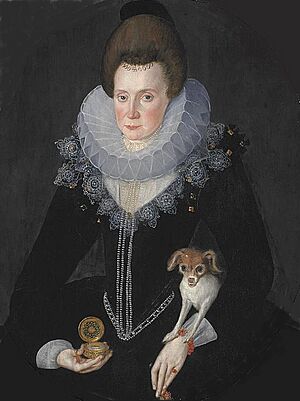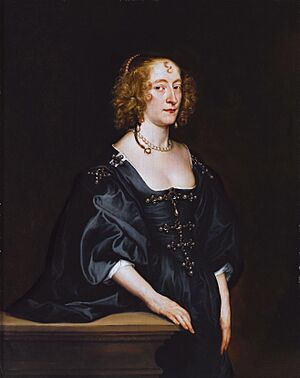William Seymour, 2nd Duke of Somerset facts for kids
Quick facts for kids The Duke of Somerset |
|
|---|---|
| KG KB | |
| William Seymour, Marquess of Hertford, later 2nd Duke of Somerset (1588–1660), portrait attributed to Gilbert Jackson (c. 1595/1600–1648), private collection | |
|
|
|
| Reign | 1660-1660 |
| Predecessor | Vacant Last held by Edward Seymour, 1st Duke of Somerset |
| Successor | William Seymour, 3rd Duke of Somerset |
| Spouse(s) | Lady Arbella Stuart Lady Frances Devereux |
| Issue | |
| Frances Darcy, Countess of Holderness William Seymour Robert Seymour Henry Seymour, Lord Beauchamp Lady Mary Seymour, Countess of Winchilsea Lady Jane Seymour, Viscountess Dungarvan John Seymour, 4th Duke of Somerset |
|
| Noble family | Seymour |
| Father | Edward Seymour, Lord Beauchamp |
| Mother | Honora Rogers |
| Born | 1588 |
| Died | 24 October 1660 (aged 71-72) |
William Seymour, 2nd Duke of Somerset (1588–1660) was an important English nobleman. He was also a military leader for the King's side, known as the Royalists or Cavaliers, during the English Civil War.
Contents
Who Was William Seymour?
William Seymour came from a very important family. His father was Edward Seymour, Lord Beauchamp, and his mother was Honora Rogers.
Family Connections to Royalty
William's grandfather was Edward Seymour, 1st Earl of Hertford. His grandmother, Lady Katherine Grey, was the sister of Lady Jane Grey, who was Queen for just nine days. This connection meant William's family had a distant link to the royal family. They were related to Mary Tudor, Queen of France, who was the younger sister of King Henry VIII of England.
William was also the great-grandson of Edward Seymour, 1st Duke of Somerset. This earlier Duke was an uncle to King Edward VI of England and served as the Lord Protector of England, meaning he ruled the country when the King was young.
Early Life and Challenges
William Seymour faced some big challenges early in his life, especially because of his family's royal connections.
A Secret Marriage and Imprisonment
In 1610, William secretly married Arbella Stuart. She was his cousin and 13 years older than him. King James VI and I was not happy about this marriage. Both William and Arbella had claims to the throne, meaning they were related to the royal family in a way that could make them potential rulers. The King saw their marriage as a threat to his own rule.
Because of this, William was sent to the Tower of London. This made him the fourth person in five generations of his family to be imprisoned there.
Escape and Separation
In 1611, William managed to escape from the Tower. He planned to meet Arbella, who had also escaped. They hoped to flee to another country. However, bad weather and other problems stopped them from meeting. Arbella was caught and sent back to the Tower.
William successfully reached safety in a place called Ostend, which is now in Belgium. Sadly, he never saw Arbella again. She remained in the Tower until she died in 1615.
William Seymour's Public Life
William Seymour became an important figure in English politics and military affairs.
Joining Parliament
In 1616, William was made a knight of the Order of the Bath. In 1620, he was elected to be a Member of Parliament for Marlborough. Soon after, in 1621, he became the Earl of Hertford after his grandfather passed away. This meant he moved from the House of Commons to the House of Lords.
In the House of Lords, William became known for disagreeing with King Charles I of England. He supported the Petition of Right in 1628, which aimed to limit the King's power. He also signed a letter from twelve important noblemen in 1640, along with his brother-in-law, Robert Devereux, 3rd Earl of Essex.
Role in the English Civil War
As the country moved closer to civil war, William Seymour started to disagree with the King's most extreme opponents. In 1641, the King made him the Marquess of Hertford.
During the English Civil War, Hertford was a moderate Royalist. This means he supported the King but also wanted to find a peaceful solution. He continued to talk with his brother-in-law Essex, who was a leader on the Parliament's side, hoping to find a compromise.
The King trusted Hertford a lot. He made him the guardian of his son, who would later become King Charles II of England. Hertford also led several important military campaigns for the King, including battles in South Wales and Somerset in 1643. He was also sent to represent the King in peace talks in 1645, which did not succeed.
After the War
After the first part of the Civil War ended, and the King was imprisoned, Hertford was one of the most important noblemen who stayed with the King. He was with King Charles I until the King was executed in 1649. Hertford and three other lords even asked the House of Commons of England if they could take the King's place and suffer death instead.
During the time when England had no king (called the Inter-regnum), Hertford stayed out of politics. He believed that the monarchy would eventually return and that plotting against the new government would only delay it.
Restoration of the Monarchy
When the monarchy was brought back in 1660, Hertford got all his old positions back. King Charles II of England also recognized his loyalty during the war. In 1660, the King gave Hertford back his great-grandfather's title, Duke of Somerset. This title had been taken away in 1552. So, William Seymour became the 2nd Duke of Somerset.
Marriages and Children
William Seymour was married two times during his life.
First Marriage
His first marriage was the secret one in 1610 to his cousin, Lady Arbella Stuart. As mentioned, this marriage caused problems with King James I. They did not have any children together.
Second Marriage and Family
On March 3, 1617, William married Lady Frances Devereux. She was the daughter of Robert Devereux, 2nd Earl of Essex. William and Frances had at least eight children together:
- Lady Frances Seymour (1618–1685): She married three times.
- William Seymour (1621–1642): He died before his father.
- Robert Seymour (1622–1646): He also died before his father.
- Henry Seymour, Lord Beauchamp (1626–1654): He married Mary Somerset, Duchess of Beaufort (1630–1715) and had children. His son, William Seymour, 3rd Duke of Somerset, became the next Duke after his grandfather. Famous people like Diana, Princess of Wales, are descendants of this line.
- Lady Mary Seymour (1637–1673): She married Heneage Finch, 3rd Earl of Winchilsea.
- Lady Jane Seymour (1637–1679): She married Charles Boyle, 3rd Viscount Dungarvan. Her descendants include Elizabeth Bowes-Lyon, who was the mother of Queen Elizabeth II.
- John Seymour, 4th Duke of Somerset (1646–1675): He became the Duke after his nephew. He married Sarah Alston but did not have children.
Death and Legacy
William Seymour died at Essex House in London on October 24, 1660. He was buried on November 1, 1660, in Great Bedwyn, Wiltshire. His grandson, William Seymour, 3rd Duke of Somerset, became the next Duke.




